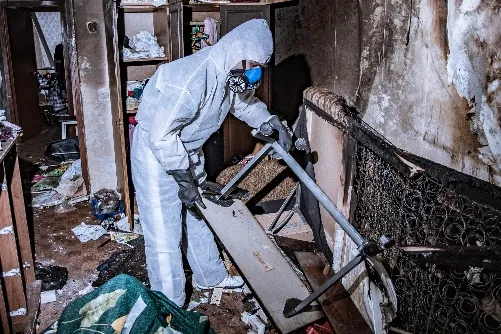
Properties that are caught by fire end up in a degraded condition. The only hope is the restoration process. Assessment and planning are essential initial steps to begin the process of reconstruction. This stage creates the groundwork for restoration. Ensuring a systematic approach to rebuilding and renewing the impacted areas. Let’s examine each aspect of this step towards fire damage restoration:
Assessment and Planning
The process of assessment and planning begins with the initial examination. Experts document the affected property to record the damage. Then, a successful recovery plan is made. The plan is based on this assessment. Every detail, from smoke damage to structural integrity, is examined to ensure everything is noticed.
Initial Inspection
Planning and evaluation set the stage for a successful fire damage restoration project. Repair specialists provide hope among the piles of destruction by conducting extensive examinations, creating detailed repair plans, and prioritizing safety precautions.
Restoration Plan
An in-depth strategy is designed. It outlines the steps required to minimize the damage. This plan gives the restoration process a clear direction by considering several issues. It includes material replacement, rebuilding, and the required time..
Safety Measurements
Safety precautions are important and should be followed throughout the whole process. Restoration experts put workers and safety first. Strict safety measures are followed in order to reduce the hazards connected with fire damage. Personal protective equipment is used to provide a safe working environment.
Cleaning and Sanitization
In fire damage repair cleaning and sanitization are important steps followed by assessment and planning. It is all about getting rid of the leftovers caused by fire. The area is cleaned and any bad odors are removed. Let’s take a deeper look at the essential elements of this phase:
Debris Removal
Waste from the fire’s aftermath covers every inch of the building. Experts remove soot and debris from damaged areas in an organized way using specific tools and methods. The whole area is carefully washed to remove the residues.
Cleaning Out Smoke
Smoke can penetrate every crack in the building. It leaves behind scents that are difficult to remove. Restoration experts use advanced techniques like air cleaning, ozone treatment, and thermal fogging to tackle this and eliminate smells at their point of origin. These methods are used to remove the unpleasant odors.
Sanitizing The Affected Area
Affected areas are sanitized properly to ensure people’s safety. Using EPA-approved disinfectants and sanitizers, restoration professionals will remove bacteria, mold, or other unsafe pathogens that may have gotten out of hand due to the fire.
Restoration and Reconstruction
Renewal and renovation are done during this step. This step ensures to bring back the property’s structural integrity, visual appearance, and functionality. Let’s examine the essential elements of this phase of transformation:
Repairing The Structure
The first thing done in the reconstruction phase is to restore the structure of the building. To determine the extent of damage and draw up specific plans for repairs, engineers work side by side with restoration teams. Attempts are taken to restore the property.
Interior Working
Attention will turn to interior finishing once structural repairs are complete. The interior design of the building is recreated by skilled workers, which makes it more attractive with modern touches. Every step of interior finishing is carefully carried out to guarantee a smooth and aesthetically pleasing outcome.
Utility Restoration
In order to restore the property’s accessibility, major utilities, structural repairs, and interior completion have to be restored. Teams specializing in restoration try to repair and reinstall HVAC, plumbing, and electrical systems. This includes fixing or replacing broken parts and ensuring the property complies with legal and safety regulations.
Post-Restoration Services
In the post-recovery phase, recovery services are provided. A thorough and efficient restoration process will be ensured at this stage, resulting in a completely restored property.
Final Inspection
Before returning the keys to the owner a thorough final inspection and testing must be carried out. In order to ensure compliance with the legal and quality standards, a review of the restoration work must be undertaken.
Documentation
Every process step, from the first evaluations to the last fixes, is recorded in the post-restoration phase. It is necessary to provide documentation since it provides a detailed record of the restoration procedure. This paperwork is a useful resource for the property owner and insurance companies.
Follow-Up
The restoration company shall provide follow-up services to ensure the satisfaction of its clients. It involves routine check-ins to handle any outstanding problems. By providing continuous support and assistance, restoration professionals are demonstrating their dedication to customer care and satisfaction.
Essential Tips On Fire Prevention
Fire-related risks can be reduced by in-depth knowledge of fire damage prevention. A thorough assessment should be done to help prevent fire-related damage. It includes checking the fuel supplies, ignition sources, and the pattern by which fire spreads. Individuals can take active steps to reduce the potential risks and prevent fire-related tragedies before they occur by fully understanding the risks of fires. In order to prevent the occurrence of fires, it is important to recognize and understand common causes. The first line of defense against possible fire risks can be identified easily. It can be done by looking for flammable goods, kitchen accidents, or defective electrical wiring. In addition, knowing the different kinds of fires like Class A are common combustibles, Class B are the flammable liquids, and Class C are the electrical fires allows people to adjust their preventative tactics appropriately.
Conclusion
Humans and properties should be protected by preventing and recovering the damage caused by fire. It focuses on reducing risks and avoiding future disasters by taking preventative measures. Following a fire tragedy, restoration focuses on reconstruction and renewal. Communities and people can work together to create a safer living environment and ensure endurance in the face of fire-related issues by realizing the significance of preventative and restoration activities.
